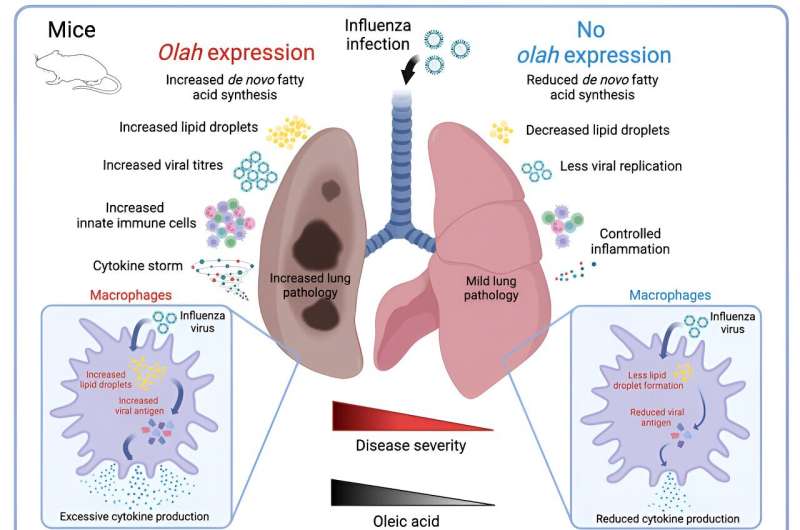This article has been reviewed according to Science X's editorial process and policies. Editors have highlighted the following attributes while ensuring the content's credibility:
fact-checked
peer-reviewed publication
trusted source
proofread
Study reveals OLAH enzyme underpins lethal respiratory viral disease

Respiratory infections can be severe—even deadly—in some individuals, but not in others. Scientists at St. Jude Children's Research Hospital, the Peter Doherty Institute for Infection and Immunity and other collaborators have gained new understanding of why this is the case by uncovering an early molecular driver that underpins fatal disease. Oleoyl-ACP-hydrolase (OLAH) is an enzyme involved in fatty acid metabolism.
A new study, published in Cell, shows that OLAH drives severe disease outcomes.
The important role of OLAH in immune response has gone unrecognized for several reasons, including a lack of noticeable expression in healthy tissue, as well as the difficulty of obtaining datasets reflecting OLAH expression before and after infection. In this study, the researchers pieced together years of collaborative projects spanning multiple diseases to create the comprehensive datasets needed to understand how OLAH works.
"OLAH directly impacts disease severity in multiple globally relevant but distinct viral infections," said co-first and co-corresponding author Jeremy Chase Crawford, Ph.D., St. Jude Department of Host-Microbe Interactions. "We started with the very specific disease context of avian influenza, but by forming these collaborations we were able to interrogate substantially broader disease contexts for this biological mechanism."
Transcriptomics reveals pivotal role of OLAH
The first clues pointing toward OLAH as a driver of lethal disease came from studies of avian A(H7N9) influenza. Transcriptomic analysis linked expression of OLAH with fatal A(H7N9) infection early after hospital admission, and OLAH levels remained high if a patient's disease progressed lethally.
Patients who recovered from their infection had low OLAH expression throughout their hospital stay. This finding led the researchers to expand their collaborations, looking for expression of OLAH in a variety of different cohorts of people who had experienced infections, as well as in mouse models of disease.
"We were generating transcriptomic datasets from several different projects, through years of studying distinct patient cohorts. It occurred to us to look at OLAH, and that's how we started to see these amazing associations across different diseases," explained Crawford, who is also a founding member of the St. Jude Center for Infectious Diseases Research.
Through this work, the investigators found high OLAH expression in patients hospitalized with life-threatening seasonal influenza, SARS-CoV-2, respiratory syntactical virus and multi-system inflammatory syndrome in children—but not during mild disease. Additional work with mouse models showed that in mice that were not expressing OLAH, infections that would otherwise be lethal were—in fact—survivable.
Additionally, the researchers found that this effect was accompanied by differential lipid droplet dynamics, reduced viral replication in macrophages and virus-induced inflammation. The work suggests that OLAH-mediated inflammatory responses and severe disease outcomes can be attributed to elevated levels of fatty acids produced by OLAH. This is supported by previous discoveries showing that viral infection in cell lines can be made worse by increased amounts of oleic or palmitic acid. The main product of OLAH is oleic acid.
Potential impact on human health and disease
Co-corresponding and senior author Katherine Kedzierska, Ph.D., Head of the Human T cell Laboratory at the Doherty Institute, highlighted the research's significance in advancing our understanding of respiratory viruses and its potential far-reaching impact on patients' health.
"We're really excited about the potential of the OLAH gene to serve as a universal indicator of disease severity across different respiratory infections," said Kedzierska.
"Imagine if your doctor could predict whether your respiratory infection will become life-threatening or if you'll recover rapidly? Our findings suggest that OLAH expression levels could be used as a cutting-edge tool in assessing patients' prognosis, empowering clinicians with crucial insights for early risk assessment and personalized treatment strategies," she added.
In addition to defining the role of OLAH in severe respiratory viral disease, the understanding that OLAH expression begins early in severe disease may make it useful as a biomarker to determine if patients need more intense initial treatment. Also, in mouse models, supplementing oleic acid increased influenza replication in macrophages and their inflammatory potential. This may mean that modulating oleic acid levels can be explored as a potential therapeutic approach to disease.
"It took years of working closely with basic scientists and clinicians, from across the world, all studying different infections and diseases, for OLAH's important role in immune response to come to light. This is just the beginning of our exploration of OLAH; there is a lot more work to be done in infectious disease and other potential applications," Crawford said.
More information: Xiaoxiao Jia et al, High expression of oleoyl-ACP hydrolase underpins life-threatening respiratory viral diseases, Cell (2024). DOI: 10.1016/j.cell.2024.07.026




















